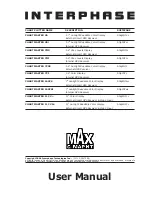
Section 10 - NMEA protocols
05/01/97 REV H
PAGE 43
Section 10 - NMEA protocols
10.1 Beacon monitor control messages
This section supplies information for special applications and for when
you require manual control of the Northstar DGPS beacon receiver.
Messages to control operation of the Northstar DGPS beacon receivers are
accepted on either the monitor or control input ports, or both. Two con-
trol protocols are implemented: NMEA 0183 and binary; either or both
may be used. This section covers the NMEA 0183 format control mes-
sages, and Section 11 covers the beacon binary protocol.
10.1.1 NMEA 0183
format control
messages
These control messages are formatted according to a widely used NMEA
0183 specification, with serial communication parameters of eight bits,
no parity, and either a standard baud rate of 4800 or a nonstandard 9600.
NMEA messages begin with a
$
character. They contain identification
and parameter fields separated by commas. They may also contain an
optional checksum (a hexadecimal value following an asterisk). If speci-
fied, the optional checksum is enforced, otherwise no checksum test is
applied. Normally, hard-wired serial data connections are so reliable that
the use of a NMEA 0183 checksum isn’t required or recommended. The
messages end with a carriage return/line feed (CR) (LF) sequence.
NMEA 0183 format control messages are buffered within the beacon
receiver until the messages are ready to be processed, then they’re ech-
oed back to the controlling device. Messages received on either the con-
trol input port or the monitor input port are echoed to the monitor
output port.
All alphabetical characters must be upper case, and messages must not
include embedded tab characters or spaces.
Here’s the NMEA 0183 format basic tuning command:
$PSLIB,frequency(CR)(LF)
where
frequency
is a decimal value (in kHz) that specifies the radio-bea-
con frequency to be received and demodulated. This frequency can be
specified with up to four digits following the decimal point, giving a tun-
ing resolution of <2 Hz. This command tunes channel 1 of the beacon
receiver to the specified frequency, and presents its demodulated RTCM
SC-104 data to the GPS receiver; channel 2 continues to scan the beacon
band.
If you specify a frequency of zero in the basic tuning command, the bea-
con receiver is commanded back to its automatic mode:
$PSLIB,0(CR)(LF)
When the bitrate of a broadcast is known as well as its frequency, it’s
highly advantageous to specify it in an extended format tuning command
as follows:
$PSLIB,frequency,bitrate(CR)(LF)
where
frequency
is in the format specified above, and
bitrate
is one
of the values 0, 25, 50, 100, or 200. (The value of zero indicates that the
Summary of Contents for 8700
Page 2: ......
Page 10: ......
Page 16: ...Section 2 Introduction PAGE 6 05 01 97 REV H ...
Page 20: ...Section 3 Packaging PAGE 10 05 01 97 REV H ...
Page 32: ...Section 6 GPS beacon combination receivers PAGE 22 05 01 97 REV H ...
Page 46: ...Section 8 Input output configurations PAGE 36 05 01 97 REV H ...
Page 52: ...Section 9 Connector pinouts PAGE 42 05 01 97 REV H ...
Page 76: ...Section 12 8X00 engine monitor program PAGE 66 05 01 97 REV H ...
Page 78: ...Section 13 Glossary PAGE 68 05 01 97 REV H ...
Page 80: ...Section 14 Abbreviations and initialisms PAGE 70 05 01 97 REV H ...
Page 85: ...Index 05 01 97 REV H PAGE 75 ...















































